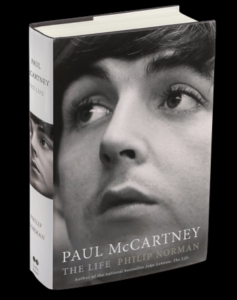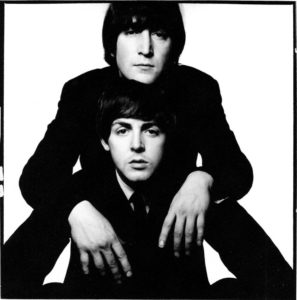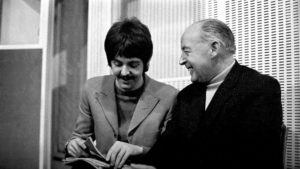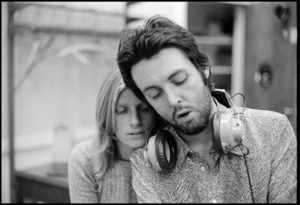The Act We’ve Known
for All These Years
From the Boston Globe, May 2, 2016
Too bad we don’t have Paul McCartney’s cell number. Maybe we could finally patch that drywall in the family room or re-route the sprinkler system in the front yard.
 Turns out Sir Paul is a do-it-yourselfer. That’s one of the things we learn about the Cute Beatle in Philip Norman’s weighty biography, Paul McCartney: The Life.’
Turns out Sir Paul is a do-it-yourselfer. That’s one of the things we learn about the Cute Beatle in Philip Norman’s weighty biography, Paul McCartney: The Life.’
At first blush, 800-plus pages on McCartney may seem like overkill, especially when we see the book isn’t pitched at music geeks. There’s no extensive discography and no how-he-did-it secrets from the recording studio. Only a fourth of the book concerns the Beatles’ glory years, perhaps because Norman has been down this road before.

In 1981, Norman published Shout!,’ one of the first and best full-career biographies of the band. McCartney resented Norman’s portrait of his songwriting partner as the real genius of the group, and often referred to the book by an unprintable mock-title using three of the same letters.
McCartney held a monumental grudge, and his resentment only grew when Norman published John Lennon: The Life in 2009. Finally, when Norman announced that no matter what Sir Paul said he was doing a McCartney bio, it was if-you-can’t-beat-him-join-him time.
McCartney told friends and family to cooperate with Norman, met with him a few times, and hoped for the best.

He got it. Norman’s portrait of McCartney is fascinating and exhaustive. This is the story of a relentless entertainer, working well into his 70s to make everybody happy. He is also portrayed as a deep contradiction: generous but petty, mostly kind but sometimes cruel. To his credit, Norman manages to avoid most of the oft-told tales, leaving the Beatles’ saga refreshed by his account.
McCartney was shaped by his midwife mother Mary — the “pretty nurse selling poppies from a tray” in “Penny Lane” — who died when he was 14. Father Jim then played both parents for Paul and Michael, his younger brother, learning to cook and passing on his love of music. Paul never recovered from the loss of his mother, but loved his father with an endearing ferocity.
McCartney was the group’s master of public relations, friendly and unfailingly polite, but also the one who delved most deeply into the avant garde, though the public perception was that Lennon was the one on the edge, according to Norman. It was McCartney, for instance, who turned John on to conceptual artists. McCartney helped finance the boho art gallery where Lennon met Yoko Ono.
Norman hits most of the high points of the well-worn Beatles narrative, but tells the story with some impatience, as if he feels it’s all common knowledge. He doesn’t say much about the writing of the songs and the recording of the albums, instead focusing more on McCartney’s cascading love life and domestic issues.
Norman spends the bulk of the book on McCartney’s long marriage to Linda Eastman and their largely successful effort to raise their children to become normal human beings. The kids suffered the normal teenage angst, but turned out OK.
Considering the crushing family fame, that’s a great testament to mom and pop. McCartney was successful with Wings, his post-Beatles band in the 1970s, but was often abused critically for his “silly love songs.’’ Despite the Lennon-McCartney credit on Beatle tunes, the two composers mostly wrote separately, though they had each other to say “this sucks” when something did.

No one dared say that to Paul McCartney, solo artist. Once on his own, McCartney missed the snide Lennon reality checks and much of his early post-Beatles music was so aggressively mediocre that it insulted the concept of mediocrity. But he occasionally found the cosmic chord he’d struck with the Beatles.
Though reviled by many Beatle fans for marrying their boy Paul, Linda was the ideal match for the musician, and Norman makes clear that the couple’s life together, personally and professionally, was deeply satisfying for both, not just a show for the benefit of the press. After her death from cancer, McCartney’s marriage to the mercurial entrepreneur and activist Heather Mills was payback for his until-then charmed life. Extracted from that six-year nightmare, McCartney wed Nancy Shevell, an old friend of Linda. By Norman’s reckoning, they appear headed for a happy ending.
For 50 years, Paul McCartney has been one of the most famous people on the planet. In this massive biography, Norman lifts the curtain to show us the real guy, and he’s somewhat different from the musician we’ve been listening to for decades. But he still largely feels like the act we’ve known for all these years.
